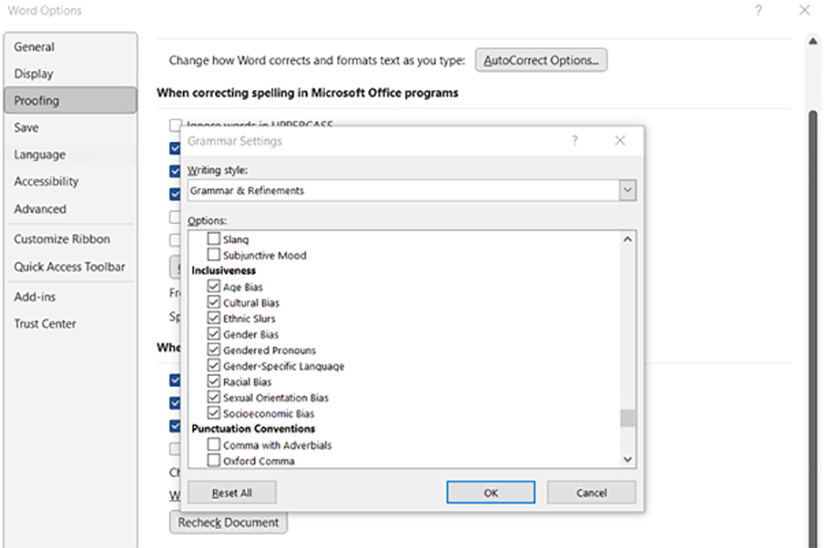inclusive language
The way we communicate reflects our priorities as a laboratory; using inclusive language is respectful and promotes equity. Following are brief discussions of common topics related to inclusivity—please use this as a starting point as you examine the words that you use and their impact.
Race
The race and ethnicity entry covers capitalization, hyphenation, and word choice. Beyond that, be mindful of terms and phrases with racist histories—these can be prevalent in both scientific writing and everyday language.
"master/slave” (replace with “parent/child” or “primary/secondary”)
“whitelisting/blacklisting,” (replace with “allow list/deny list” or similar)
“brown bag” (replace with “lunch and learn”)
Disability
All written, audio, and visual products at NREL must comply with Section 508, which allows assistive technology (e.g., a screen reader) to relay information to a person. Visit the 508 compliance entry to learn more about captions, alt text, and clear navigation of PDFs, webpages, and more.
Also, take care to avoid using unintentionally ableist language. Examples like “blind to,” “fall on deaf ears,” “crippled by,” and so on imply that people with these disabilities are ignorant or helpless. Instead, reword your sentences to be specific and clear with what you are trying to convey.
Gender
Whenever possible, use words that apply to any gender, such as “moderator” rather than “chairman” or “manufactured” rather than “man-made.” In addition, honor the pronouns that a person has chosen to describe themself. Note that the nongendered “they” is appropriate in reference to a single person or a group of people; further, “they” is preferred over “he/she,” which often feels cumbersome in text and is less comprehensive.
The AP Stylebook has entries on inclusive storytelling and gender-neutral language.
Sexuality, Age, Religion, and Socioeconomic Status
Be mindful in your writing to not assume victimhood or inadvertently apply stereotypes. For example, rather than “poverty-stricken,” use “low-income.” Instead of “elderly,” use “older adults.” Avoid “the” descriptors (e.g., “the homeless,” “the poor”) because they are usually dehumanizing. Also, when considering identity-based descriptors such as sexuality, age, or religion, consider whether the descriptor is appropriate to include. If it is not relevant to the story, there are often more neutral ways of describing a person or group.
Inclusiveness Check
Microsoft Word offers an inclusiveness check as part of its proofing options. However, similar to how spell-checkers do not replace review by an editor, this inclusiveness check does not replace common sense regarding eliminating biases and promoting respect. To turn on this inclusiveness check, go to File > Options > Proofing, click on the “Settings” button next to “Writing Style,” and check all the boxes under the “Inclusiveness” heading.

Other Resources
There are many resources available about inclusive language and promoting diversity and equity in your writing. Following are a few that may be helpful:
Centers for Disease Control and Prevention. 2022. “Preferred Terms for Select Population Groups & Communities.” https://www.cdc.gov/healthcommunication/Preferred_Terms.html.
Ferguson, Jackie, Kaela Kovach-Galton, and Roxanne Bellamy. 2020. Say This, Not That: Activating Workplace Diversity Through Inclusive Language Practice. The Diversity Movement. https://thediversitymovement.com/wp-content/uploads/2020/11/WW-SayThis-whitepaper_201116-F.pdf.
Google. 2021. “Striving for a more inclusive workplace? Start by examining your language.” https://www.thinkwithgoogle.com/intl/en-ssa/future-of-marketing/management-and-culture/diversity-and-inclusion/diverse-workplace-inclusive-language/.
Inclusive Naming Initiative. 2023. “Frequently Asked Questions.” https://inclusivenaming.org/faqs/.
Lawrence Livermore National Laboratory. 2022. Pronouns Matter Everyday. LLNL-BR-831843. https://www.llnl.gov/sites/www/files/2022-03/Pronouns_Matter_%2020220308.pdf.
Linguistic Society of America. 2016. “Guidelines for Inclusive Language.” https://www.linguisticsociety.org/resource/guidelines-inclusive-language.
Questions can be directed to the Editorial Board or the Office of Diversity and Inclusion.
Share
Last Updated Dec. 9, 2024
